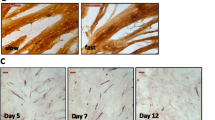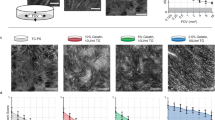Summary
Highly contractile skeletal myotubes differentiated in tissue culture are normally difficult to maintain on collagen-coated tissue culture dishes for extended periods because of their propensity to detach as a sheet of cells from their substratum. This detachment results in the release of mechanical tension in the growing cell “sheet” and, consequently, loss of cellular protein. We developed a simple method of culturing high density contractile primary avian myotubes embedded in a collagen gel matrix (collagel) attached to either a stainless steel mesh or nylon support structure. With this system the cells are maintained in a highly contractile state for extended periods in vitro under tension. Structural integrity of the myotubes can be maintained for up to 10 d in basal medium without serum or embryo extract. Total cellular protein and myosin heavy chain accumulation in the cells can be maintained for weeks at levels which are two to three times those found in timematched controls that are under little tension. Morphologically, the myotubes are well differentiated with structural characteristics of neonatal myofibers. This new collagel culture system should prove useful in the analysis of in vitro gene expression during myotube to myofiber differentiation and its regulation by various environmental factors such as medium growth factors, innervation, and mechanical activity.
Similar content being viewed by others
References
Ashmore, C. R.; Summers, P. J. Stretch-induced growth in chicken wing muscles: Myofibrillar proliferation. Am. J. Physiol. 51:C93-C97; 1981.
Bell, E.; Ivarsson, B.; Merrill, C. Production of tissue-like structure by contraction of collagen lattices by human fibroblasts of different proliferative potentialin vitro. Proc. Natl. Acad. Sci USA 76:1274–1278; 1979.
Buckingham, M. Muscle cells in tissue culture. Int. Rev. Biochem. 15:315–322; 1977.
Buckingham, M. E. Actin and myosin multigene families: Their expression during the formation of skeletal muscle. Essays Biochem. 20:77–109; 1985.
Caplan, A. I.; Fitzman, M. Y.; Eppenberger, H. M. Molecular and cell isoforms during development. Science 221:921–927; 1983.
Chambard, M.; Gabron, J.; Mauchamp, J. Influence of collagen gel on the orientation of epithelial cell polarity: Follicle formation from isolated thyroid cells and from preformed monolayers. J. Cell Biol. 91:157–166; 1981.
Coleman, J. R.; Coleman, A. W. Muscle differentiation and macromolecular synthesis. J. Cell. Physiol. 72:19–34; 1968.
De la Haba G.; Kamali, H. M.; Tiede, D. M. Myogenesis of avian striated musclein vitro: Role of collagen in myofiber formation. Proc. Natl. Acad. Sci. USA 72:2729–2732; 1975.
Ecob, M.; Butler-Browne, G. S.; Whalen, R. G. The adult fast isozyme of myosin is present in a nerve-muscle tissue culture system. Differentiation 25:84–87; 1983.
Fambrough, D. M.; Bayne, E. K.; Gardner, J. M., et al. Monoclonal antibodies to skeletal muscle cell surface. In: Brockes, J., ed.Neuroimmunology, New York: Plenum Press; 1982: 49–89.
Fischman, D. A. Myofibrillar assembly in skeletal muscle. In: Bourne, G. H., ed. The structure and function of muscle. vol. 1. New York: Academic Press; 1973:75–148.
Gardner, J. M.; Fambrough D. Fibronectin expression during myogenesis. J. Cell Biol. 96:474–485; 1983.
Hall, H. G.; Farson, D. A.; Bissell, M. J. Human formation by epithelial cell lines in response to collagen overlay: A morphogenetic model in culture. Proc. Natl. Acad. Sci. USA 79:4672–4676; 1982.
Hay, E. D. Cell biology of the extracellular matrix. New York: Plenum Press; 1982.
Hauschka S. D.; Konigsberg, I. R. The influence of collagen on the development of muscle clones. Proc. Natl. Acad. Sci USA 55:119–126; 1966.
Jablecki, C.; Kaufman, S. Myosin adenosine triphosphatase activity during work-induced growth of slow and fast skeletal muscle in the normal rat. J. Biol. Chem. 248:1056–1062; 1973.
Kelly, A. M.; Zacks, S. I. The histogenesis of rat intercostal muscle. J. Cell Biol. 42:135–153; 1969.
Kleinman, H. K.; Klebe, R. J.; Martin, G. R. Role of collagenous matrices in the adhesion and growth of cells. J. Cell Biol. 88:473–485; 1981.
Konigsberg, I. R.; McElvain, N.; Tootle, M., et al. The dissociability of DNA synthesis from the development of multinuclearity of muscle cell in culture. J. Biophys. Biochem. Cytol. 8:333–343; 1960.
Konigsberg, I. R. Diffusion-mediated control of myoblast fusion. Dev. Biol 26:133–152; 1971.
Labarca, C.; Paigen, K. A simple rapid and sensitive DNA assay procedure. Anal. Biochem. 102:344–352; 1980.
Lowry, O. H.; Rosebrough, N. J.; Farr, A. L., et al. Protein measurement with the Folin phenol reagent. J. Biol. Chem. 193:265–275; 1954.
Moss, P. S.; Spector, D. H.; Glass, C. A., et al. Streptomycin retards the phenotypic maturation of chick myogenic cells. In Vitro 20:473–478; 1984.
Murray, M. R. Skeletal muscle in culture. In: Bourne, G. H., ed. Structure and function of muscle, vol. I, part I. New York: Academic Press; 1972: 237–299.
Paterson, B.; Strohman, R. C. Myosin synthesis in cultures of differentiating chicken embryo skeletal muscle. Dev. Biol. 29:113–138; 1972.
Sheehan, D. C.; Hrapchak, B. B. Theory and practice of histochemistry, 2nd ed. St. Louis: C. V. Mosby Co.; 1980: 143.
Stockdale, F. E.; Holtzer, H. DNA synthesis and myogenesis. Exp. Cell Res. 24:508–520; 1961.
Vandenburgh, H. H. Separation of plasma membrane markers by glycerol-induced blistering of muscle cells. Biochem. Biophsy. Acta 466:302–314; 1977.
Vandenburgh, H. H.; Kaufman, S.In Vitro model for stretch-induced hypertrophy of skeletal muscle. Science 203:265–268; 1979.
Vandenburgh, H. H. Cell shape and growth regulation in skeletal muscle: exogenous versus endogenous factors. J. Cell Physiol. 116:363–371; 1983.
Vandenburgh, H. H. Relationship of muscle growthin vitro to sodium pump activity and transmembrane potential. J. Cell Physiol. 119:283–295; 1984.
Walker, C.; Strohman, R. Myosin turnover in cultured muscle fibers relaxed by tetrodotoxin. Exp. Cell Res. 116:341–348; 1978.
Waterlow, J. C.; Garlick, P. J.; Millward, D. J., Editors. Protein turnover in mammalian tissues and in the whole body. Amsterdam, Netherlands: North-Holland; 1978:529–594.
Yang, J.; Richards, J.; Bowman, P., et al. Sustained growth and three-dimensional organization of primary mammary tumor epithelial cells embedded in collagen gels. Proc. Natl. Acad. Sci. USA 76:3401–3405; 1979.
Author information
Authors and Affiliations
Additional information
This work was supported by grant AM 36266 from the National Institutes of Health, Bethesda, MD, and grant NAG2-414 from the National Aeronautics and Space Administration, Washington, D.C.
Parts of this work have appeared in abstract form, In Vitro 23:24a; 1987.
Rights and permissions
About this article
Cite this article
Vandenburgh, H.H., Karlisch, P. & Farr, L. Maintenance of highly contractile tissue-cultured avian skeletal myotubes in collagen gel. In Vitro Cell Dev Biol 24, 166–174 (1988). https://doi.org/10.1007/BF02623542
Received:
Accepted:
Issue Date:
DOI: https://doi.org/10.1007/BF02623542




